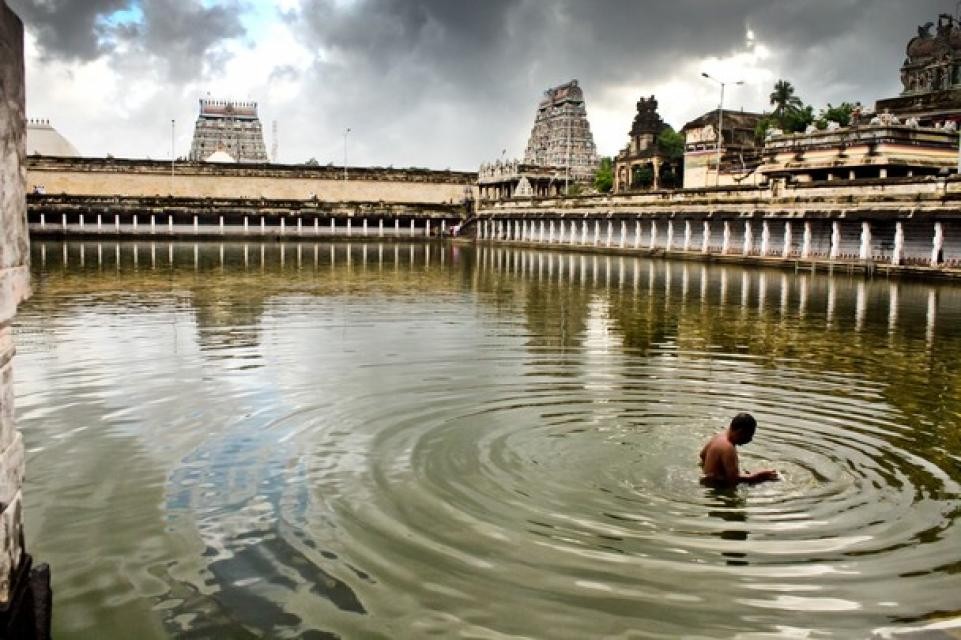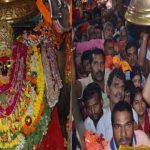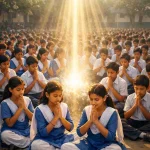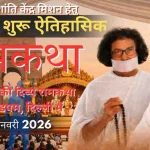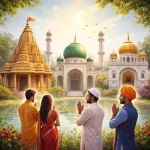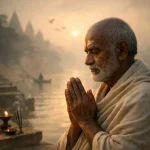This is the Last in the five part Shiva series of articles that have been published in this week of Sravana Month.
Most of us have definitely seen to the famous Nataraja idol. Nataraja meaning Lord of the dance is the prominent visible idol at the famous Chidambaram temple in Tamil Nadu. Chidambaram has been a main pilgrimage center for all the devotees of Lord Shiva since about the ninth century, at that time Chidambaram was known as Thillai.
Chidambaram is combination of “chitt”, which means conscience and “ambara” means “Akash”. This is the most unique Temple of the Shiva, here Lord Shiva is worshipped as Chidambaram, as Space (Akash), one of the five elements of universe. One cannot see a deity here but the form of the lingam is clearly visible in the light of the lamps in the inner Sanctorium.

It is said that once a Kashmiri king who was suffering with a terminal disease bathed in the temple tank and was cured. And in appreciation to the deity he is said to have enlarged the temple. Chidambaram is known for its Phallie-Shaped ungams of light, which are set in bases of the vulvic goddess; they are primary iconic symbol of Shiva.
Nataraja temple is one of the most important and ancient in southern India and devotees from all parts of country visit the temple all the year round. The idol of Nataraja (Shiva in his dancing aspects) is separated from the holy of Holies by a veil which is removed only on specified occasions of worship. Behind the veil is revealed mere space, out of which the heavenly Nataraja is said to have emerged.
Chidambaram – The Temple Town
Chidambaram was originally a forest of Thillai trees (Thillai Vana). The presiding deity of this forest was Kali, Goddess in Her fierce form. Sages Patanjali and Vyagrapada were doing penance in the Thillai forests to have darshan of Lord Shiva. Patanjali was originally Adisesha who longed to witness the dance of the Lord. He came to the earth as the son of Atri Maharishi and Anusuya. Puranas speak of how the child fell into the folded hands of Anusuya, giving it the name Pata-Anjali. Vyagrapada was the son of a Rishi from Kashi. Both were worshipping Lord Shiva in the form of a Swayambu Linga (self-manifested) in the Thillai forest. This Linga is known as Srimoolanatha. Vyagrapada, through his penance, was blessed with a tigers feet and eyes. He could climb trees fast and get choice flowers and was worshipping the Lord.
Shiva once assumed the form of Bikshaadanar and came to Dhaarukaavana in the company of Vishnu as Mohini to quell the pride of Rishis and their wives. In His mission, the Lord killed a tiger that emerged from the holy fire raised by Rishis and wore its skin. Then came a serpent, which He caught hold of and adorned round His neck. The next form to appear from the holy fire was Muyalaka (Apasmara purusha symbolic of ignorance), whom the Lord stamped under His feet and danced, witnessed by Brahma,Vishnu and the Devas. In the Thillai forest, the Lord had to contain the pride of Kali and give darshan to Vyagrapada and Patanjali. A serious dance contest between the two followed. As Kali was struggling to keep pace with the Lord, Shiva performed the Urdhwa Thaandava. While doing this, His ear-ring fell on the ground. With a master stroke the Lord picked it up with one of His feet and put it back in His ear. Kali failed to do this and conceded defeat to Lord Shiva.

On the outskirts of Chidambaram, there is a shrine dedicated to Thillai Kali. The present Kali shrine was built by a Chola king in the 13th century. In later years, Simha Varma, a king of North India, came to the South on a pilgrimage. He was suffering from a serious skin disease. When he passed through the Thillai forest, he worshipped Srimoolanatha after a holy dip in a nearby tank. To his surprise, he was completely cured of the disease and he started shining like gold. Later he was named as Hema Varma and the tank was called Hema Pushkarini or Shivaganga. The king built a proper shrine for the Linga and also brought 3,000 Deekshitas, Brahmins well versed in Vedas and Shastras, for the puja and administration of the shrine. The tradition of Deekshitas administering the temple and performing pujas is followed even today
The two great festivals celebrated at Thillai Nataraja temple in Chidambaram include Margazhi Thiruvadhirai and Aani Thirumanjanam
Annamalaiyar Temple is dedicated to Lord Shiva and is located at the base of the Annamalai Hills in the town of Thiruvannamalai in Tamil Nadu. Here Shiva is here worshiped as Arunachaleswara. The temple is one of the Pancha Bhoota Stalas and represents the Agni (Fire) element. The lingam here is Agni lingam and his consort Parvathi is known as Unnamulai Amman.
Arunachaleswara is in an ancient town dotted with numerous temples along the Girivalam, a 14km pathway that devotees use to circumnavigate the Annamalai hills before entering the town’s main temple. It is believed that the Tiruvannamalai hills are rich in herbs, it has the reputation of being as one of the best centre for Sidda Medicine and Yoga. Every full-moon night, lakhs of devotees arrive here for the holy Girivalam (perambulation).
Must Read https://www.religionworld.in/shiva-temples-arunachaleswara-abode-light/
History of the Temple
The temple complex is spread across 10 hectares and is one of the largest temples in India. The temple has four gateway towers known as gopurams and the tallest is the eastern tower with 11 stories and a height of 217 ft, which also makes it one of the tallest temple towers in the country. The temple complex houses numerous shrines apart from the shrines of Shiva and Parvathi and also has many halls. The most notable is the thousand-pillared hall built during the Vijayanagar period. The present stone works and towers date back to the 9th century by the Chola Kings. Prior to the Chola’s Thiruvannamalai was under the Pallava Kings who ruled from Kanchipuram.
Architechture
There are Four Gopurams in four directions and a Thousand-Pillared Hall at the bottom of the Annamalai Hills and the Main Temple faces east. The eastern tower or the Rajagopuram is the tallest amongst the four. The construction of this tower was started by Krishnadevaraya of the Vijayanagara empire and was completed by Sevappa Nayaka. The south tower is called Thirumanjangopuram, the west tower is known as Pei Gopuram and the north tower is named after Ammani Ammal, a sanyasini who built it. Each Gopuram’s hold a huge Nandi( the vehicle of Shiva). The other towers here are Kili Gopuram or parrot tower and the Vallala Maharaja Gopuram. To reach the innermost sanctum one must pass through five prakarams or compounds.
One can find a sixteen-pillared Deepa Darshana Mandapam (hall of light) at the third precinct. In the fourth precinct one can find a six-foot-tall Nandi which was erected by Vallala Maharaja. A thousand-pillared hall built during the late Vijayanagara period by Krishnadevaraya along with the temple tank can be found in the fifth precinct. The pillars in the hall are carved with images of Yali, a mythological beast with the body of a lion and the head of an elephant.
Siva Temple & Structure of Human Body
A classical Siva temple as per Agama rules will have five prakaras or circuits each separated by walls one within the other. The outer prakaras will be open to the sky except the innermost one. The innermost one will house the main deity as well as other deities. There will be a massive wooden or stone flag post exactly in line with the main deity.
Shiva Temples : “Jambukeswara Temple” Purity of Devotion
The innermost prakara houses the sanctum sanctorum ( karuvarai in Tamil). In it sits Shiva, the supreme Lord.
Symbolism behind the structure of a Shiva Temple is that the temple is constructed as to resemble the human body with all its subtleties. The five walls encircling one another are the kosas (sheaths) of human existence. The outermost is the Annamaya kosa , symbolizing the material body. The second is Pranamaya kosa , symbolizing the sheath of vital force or prana. The third is Manomaya kosa, symbolizing the sheath of the thoughts, the mana. The fouth is the Vignyana maya kosa, symbolizing, the sheath of the intellect. The fifth and innermost is the Ananda maya kosa, symbolizing the sheath of Bliss.
The sanctum which is in the prakara symbolizing the Ananda Maya Kosa sheath, houses the lord, seated as the Jiva within us. It is to be noted that the sanctum is an unlit space, just as if within the heart closed on all sides. The entry Gopuras are likened to the feet, as resembling a person who is lying on the back with the toe up. The flag post depicts the sushumna nadi which raises from the Mooladhar (base of the spine) to the sahasrar (vertex in the head).
Some temples will have three prakarams. There they represent the stoola, sukshma and karana sareeras (bodies) of a human being.
What does Chidambaram Temple signify?
- Nataraja’s dance is said to indicate the five divine acts which are Creation, Protection, Destruction, Act of Hiding, and Act of Bestowing.
Creation: Nataraja dances with a small drum called damarukam in one of his right hands. Easwra is nada brahmam. He is the origin of all sounds (nadam).This is the seed (vindu) from which the tree of the Universe emanated.
Protection (Operation): In another of the right hands, he shows the ‘Abhaya Mudra’, meaning he is the kind protector.
Destruction: He has fire in one of his left hands, symbolizing destruction. When everything is destroyed by fire, only the ash will remain which the Lord has smeared on body.
The foot which is planted shows the act of hiding; and the raised foot shows the act of bestowing.

Nataraja Swamy has the Vigraha ( icon) of Devi Sivakama Sundari to his left . This symbolizes Ardhanareeswara , ‘ the Lord who has the female as his left half’. To his right there is a screen. When the deeparadhana – showing lamps takes place to the swamy and to the left side , the screen is removed and we see five vertical long hangings of golden vilva leaves. We see nothing behind it. Sivakami shows the Saguna Brahman (the God with a form) that is Nataraja . The Saguna Brahman leads us to the Nirguna Brahman (the God without form or the God who has formlessness as his form). This is told as ‘Chidambara Rahasyam’ by the Dikshitars , who are the traditional pujaris in the temple.
Shiva’s dance is called the celestial dance by many scholars. In Chidambaram, this dance is called ‘Ananda Tandava’. Lord Maha Vishnu also saw the Divine dance. In a nearby mantapa called Chitrakoota, Maha Vishnu, gives us dharshan in his fully reclining Yoga Nidra pose on the snake bed. If one stands on a small lotus sculpted on the floor slab in front of Narayana, one can at the same time see Nataraja in his right side. Sages Patanjali and Thirumoolar also saw Nataraja’s dance in Chidambaram. Their figures are embossed on the Silver doors of the Chit Sabha.

